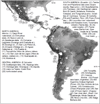Arsenic exposure in Latin America: biomarkers, risk assessments and related health effects
- PMID: 22119448
- PMCID: PMC3977337
- DOI: 10.1016/j.scitotenv.2011.08.051
Arsenic exposure in Latin America: biomarkers, risk assessments and related health effects
Abstract
In Latin America, several regions have a long history of widespread arsenic (As) contamination from both natural and anthropological sources. Yet, relatively little is known about the extent of As exposure from drinking water and its related health consequences in these countries. It has been estimated that at least 4.5 million people in Latin America are chronically exposed to high levels of As (>50 μg/L), some to as high as 2000 μg/L--200 times higher than the World Health Organization (WHO) provisional standard for drinking water. We conducted a systematic review of 82 peer reviewed papers and reports to fully explore the current understanding of As exposure and its health effects, as well as the influence of genetic factors that modulate those effects in the populations of Latin America. Despite some methodological limitations, these studies suggested important links between the high levels of chronic As exposure and elevated risks of numerous adverse health outcomes in Latin America--including internal and external cancers, reproductive outcomes, and childhood cognitive function. Several studies demonstrated genetic polymorphisms that influence susceptibility to these and other disease states through their modulation of As metabolism, with As methyltransferase (AS3MT), glutathione S-transferase (GST), and genes of one-carbon metabolism being specifically implicated. While the full extent and nature of the health burden are yet to be known in Latin America, these studies have significantly enriched knowledge of As toxicity and led to subsequent research. Targeted future studies will not only yield a better understanding of the public health impact of As in Latin America populations, but also allow for effective and timely mitigation efforts.
Copyright © 2011. Published by Elsevier B.V.
Conflict of interest statement
The authors declare that there are no conflicts of interest and no competing financial interests.
Figures
References
-
- ACGIH. American Conference of Governmental Industrial Hygienists (ACGIH) Biological exposure index (BEI) TLVs and BEIs. 7th Edition 2009.
-
- Ackerman AH, Creed PA, Parks AN, Fricke MW, Schwegel CA, Creed JT, et al. Comparison of a chemical and enzymatic extraction of arsenic from rice and an assessment of the arsenic absorption from contaminated water by cooked rice. Environ Sci Technol. 2005;39:5241–5246. - PubMed
-
- Adonis M, Martinez V, Marin P, Berrios D, Gil L. Smoking habit and genetic factors associated with lung cancer in a population highly exposed to arsenic. Toxicol Lett. 2005a;159:32–37. - PubMed
-
- Adonis M, Martinez V, Marin P, Gil L. CYP1 Al and GSTM1 genetic polymorphisms in lung cancer populations exposed to arsenic in drinking water. Xenobiotica. 2005b;35:519–530. - PubMed
Publication types
MeSH terms
Substances
Grants and funding
LinkOut - more resources
Full Text Sources
Medical
Research Materials




